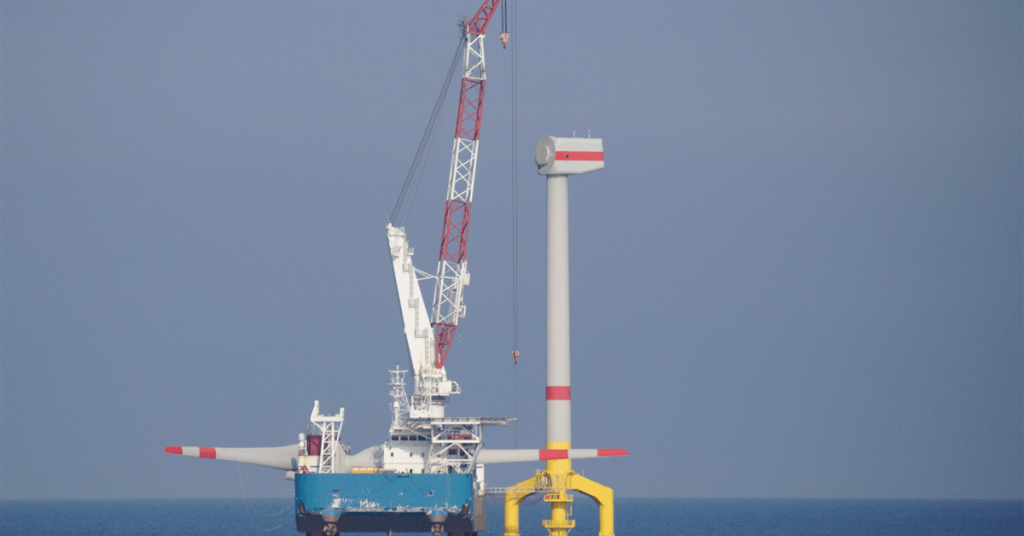Orlen Group and Northland Power have completed the installation of the first of 15-megawatt wind turbines in Polish waters for the Baltic Power project. The company said in a media release that the Vestas units are the largest offshore wind turbines to be installed in Europe.
Orlen said that as early as next year, the Baltic Power offshore wind farm will be capable of covering up to 3 percent of Poland’s electricity demand.
“We have entered a key stage in the execution of a project that is truly reshaping the Polish energy landscape. Diversifying our power generation sources and reducing dependence on fossil fuels are crucial steps towards enhancing our long-term energy resilience, especially vital amid today’s geopolitical instability”, Ireneusz Fąfara, CEO and President of the Management Board of Orlen, said. “Having ended the region’s reliance on Russian hydrocarbons, we are now turning the page to begin a new chapter in Poland’s energy history. This project equips us with the expertise that will drive the development of further offshore wind farms outlined in our strategic plan”.
The operational commissioning of the farm is expected in 2026. Baltic Power will be the first offshore wind farm to supply electricity to Poland. Orlen Group said it is planning to develop additional projects with a total capacity of approximately 5.5 gigawatts in partnership with other entities.
Each turbine tower surpasses 120 meters (393 feet) in height, with the entire structure – including foundations – reaching 250 meters (820 feet), Orlen said. Some Baltic Power turbine towers are constructed from recycled steel, a first in wind farm development, according to Orlen. The nacelles, comparable in size to a three-story house, are mounted on the towers and fitted with blades that are 115 meters (377 feet) long. This results in a swept area of 43,700 square meters (470,380 square feet), the company said.
“Constructing an offshore wind farm is a massive engineering and logistical challenge, requiring the synchronized effort of up to 15 different vessels. What makes this joint project between Orlen and Northland Power even more meaningful is the local content: many components, including some of the nacelles, are manufactured right here in Poland at the Vestas new plant in Szczecin. They complement other domestically produced elements such as topsides of offshore substations, onshore cables, and elements of foundations”, Grzegorz Szabliński, President of the Management Board of Baltic Power, said.
The jack-up vessel Wind Osprey is carrying out the installations. Capable of carrying up to 11,000 tons of weight, the vessel can transport three complete wind turbines in a single trip. Its cranes were upgraded in 2024 and are now able to lift 1,600 tons. In parallel, monopoles and transition pieces are being installed on the offshore construction site. Preparations have also started for the installation of inter-array and export cables, Orlen said, adding that offshore substations are scheduled to be installed later in autumn. Cadeler, the owner of the Wind Osprey, added that the vessel will transport and install all 74 turbines from the Port of Ronne.
Onshore construction is also ongoing. In April, the construction of an operations and maintenance base in Leba was completed.
To contact the author, email andreson.n.paul@gmail.com
What do you think? We’d love to hear from you, join the conversation on the
Rigzone Energy Network.
The Rigzone Energy Network is a new social experience created for you and all energy professionals to Speak Up about our industry, share knowledge, connect with peers and industry insiders and engage in a professional community that will empower your career in energy.
element
var scriptTag = document.createElement(‘script’);
scriptTag.src = url;
scriptTag.async = true;
scriptTag.onload = implementationCode;
scriptTag.onreadystatechange = implementationCode;
location.appendChild(scriptTag);
};
var div = document.getElementById(‘rigzonelogo’);
div.innerHTML += ” +
‘‘ +
”;
var initJobSearch = function () {
//console.log(“call back”);
}
var addMetaPixel = function () {
if (-1 > -1 || -1 > -1) {
/*Meta Pixel Code*/
!function(f,b,e,v,n,t,s)
{if(f.fbq)return;n=f.fbq=function(){n.callMethod?
n.callMethod.apply(n,arguments):n.queue.push(arguments)};
if(!f._fbq)f._fbq=n;n.push=n;n.loaded=!0;n.version=’2.0′;
n.queue=[];t=b.createElement(e);t.async=!0;
t.src=v;s=b.getElementsByTagName(e)[0];
s.parentNode.insertBefore(t,s)}(window, document,’script’,
‘https://connect.facebook.net/en_US/fbevents.js’);
fbq(‘init’, ‘1517407191885185’);
fbq(‘track’, ‘PageView’);
/*End Meta Pixel Code*/
} else if (0 > -1 && 75 > -1)
{
/*Meta Pixel Code*/
!function(f,b,e,v,n,t,s)
{if(f.fbq)return;n=f.fbq=function(){n.callMethod?
n.callMethod.apply(n,arguments):n.queue.push(arguments)};
if(!f._fbq)f._fbq=n;n.push=n;n.loaded=!0;n.version=’2.0′;
n.queue=[];t=b.createElement(e);t.async=!0;
t.src=v;s=b.getElementsByTagName(e)[0];
s.parentNode.insertBefore(t,s)}(window, document,’script’,
‘https://connect.facebook.net/en_US/fbevents.js’);
fbq(‘init’, ‘1517407191885185’);
fbq(‘track’, ‘PageView’);
/*End Meta Pixel Code*/
}
}
// function gtmFunctionForLayout()
// {
//loadJS(“https://www.googletagmanager.com/gtag/js?id=G-K6ZDLWV6VX”, initJobSearch, document.body);
//}
// window.onload = (e => {
// setTimeout(
// function () {
// document.addEventListener(“DOMContentLoaded”, function () {
// // Select all anchor elements with class ‘ui-tabs-anchor’
// const anchors = document.querySelectorAll(‘a .ui-tabs-anchor’);
// // Loop through each anchor and remove the role attribute if it is set to “presentation”
// anchors.forEach(anchor => {
// if (anchor.getAttribute(‘role’) === ‘presentation’) {
// anchor.removeAttribute(‘role’);
// }
// });
// });
// }
// , 200);
//});

